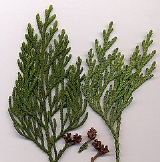
Thuja
Overview
Thuja is a genus of coniferous tree
s in the Cupressaceae
(cypress family). There are five species in the genus, two native to North America
and three native to eastern Asia
. The genus is monophyletic
and sister to Thujopsis
.
They are commonly known as arborvitaes (from Latin
for tree of life) or thujas; several species are widely known as cedar but because they are not true cedars (Cedrus) it has been recommended to call them redcedars or whitecedars.
Thujas are evergreen
tree
s growing from 10 to 60 ft (3 to 18.3 m) tall, with stringy-textured reddish-brown bark
.
Tree
A tree is a perennial woody plant. It is most often defined as a woody plant that has many secondary branches supported clear of the ground on a single main stem or trunk with clear apical dominance. A minimum height specification at maturity is cited by some authors, varying from 3 m to...
s in the Cupressaceae
Cupressaceae
The Cupressaceae or cypress family is a conifer family with worldwide distribution. The family includes 27 to 30 genera , which include the junipers and redwoods, with about 130-140 species in total. They are monoecious, subdioecious or dioecious trees and shrubs from 1-116 m tall...
(cypress family). There are five species in the genus, two native to North America
North America
North America is a continent wholly within the Northern Hemisphere and almost wholly within the Western Hemisphere. It is also considered a northern subcontinent of the Americas...
and three native to eastern Asia
Asia
Asia is the world's largest and most populous continent, located primarily in the eastern and northern hemispheres. It covers 8.7% of the Earth's total surface area and with approximately 3.879 billion people, it hosts 60% of the world's current human population...
. The genus is monophyletic
Monophyly
In common cladistic usage, a monophyletic group is a taxon which forms a clade, meaning that it contains all the descendants of the possibly hypothetical closest common ancestor of the members of the group. The term is synonymous with the uncommon term holophyly...
and sister to Thujopsis
Thujopsis
Thujopsis is a conifer in the cypress family , the sole member of the genus being Thujopsis dolabrata. It is endemic to Japan, where it is named asunaro . It is similar to the closely related genus Thuja , differing in the broader, thicker leaves and thick cones...
.
They are commonly known as arborvitaes (from Latin
Latin
Latin is an Italic language originally spoken in Latium and Ancient Rome. It, along with most European languages, is a descendant of the ancient Proto-Indo-European language. Although it is considered a dead language, a number of scholars and members of the Christian clergy speak it fluently, and...
for tree of life) or thujas; several species are widely known as cedar but because they are not true cedars (Cedrus) it has been recommended to call them redcedars or whitecedars.
- Thuja koraiensisThuja koraiensisThuja koraiensis is a species of Thuja, native to Korea and the extreme northeast of China . Its current status is poorly known; the small population in China is protected in the Changbaishan Nature Reserve, as is the small population in Soraksan Nature Reserve in northern South Korea, but most of...
- Korean Thuja - Thuja occidentalisThuja occidentalisThuja occidentalis is an evergreen coniferous tree, in the cypress family Cupressaceae, which is widely cultivated for use as an ornamental plant known as American Arbor Vitae. The endemic occurrence of this species is a northeastern distribution in North America...
- Eastern Arborvitae, Northern Whitecedar - Thuja plicataThuja plicataThuja plicata, commonly called Western or pacific red cedar, giant or western arborvitae, giant cedar, or shinglewood, is a species of Thuja, an evergreen coniferous tree in the cypress family Cupressaceae native to western North America...
- Western Redcedar - Thuja standishiiThuja standishiiThuja standishii is a species of thuja, an evergreen coniferous tree in the cypress family Cupressaceae. It is native to southern Japan, where it occurs on the islands of Honshū and Shikoku...
- Japanese Thuja - Thuja sutchuenensisThuja sutchuenensisThuja sutchuenensis is a species of thuja, an evergreen coniferous tree in the cypress family Cupressaceae. It is native to China, where it is a critically endangered local endemic in Chongqing Municipality in eastern Sichuan....
- Sichuan Thuja
Thujas are evergreen
Evergreen
In botany, an evergreen plant is a plant that has leaves in all seasons. This contrasts with deciduous plants, which completely lose their foliage during the winter or dry season.There are many different kinds of evergreen plants, both trees and shrubs...
tree
Tree
A tree is a perennial woody plant. It is most often defined as a woody plant that has many secondary branches supported clear of the ground on a single main stem or trunk with clear apical dominance. A minimum height specification at maturity is cited by some authors, varying from 3 m to...
s growing from 10 to 60 ft (3 to 18.3 m) tall, with stringy-textured reddish-brown bark
Bark
Bark is the outermost layers of stems and roots of woody plants. Plants with bark include trees, woody vines and shrubs. Bark refers to all the tissues outside of the vascular cambium and is a nontechnical term. It overlays the wood and consists of the inner bark and the outer bark. The inner...
.
Unanswered Questions

